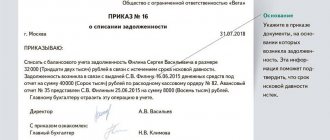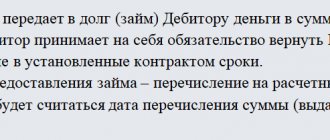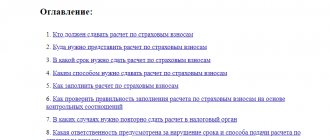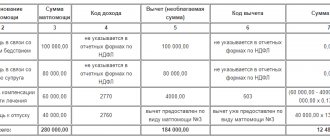What is it and when does it occur
Material benefit under a loan agreement is the amount generated when signing an agreement on an interest-free or preferential loan, calculated as the borrower saving money on interest payments. Of this, 35% is paid as personal income tax, which has been approved since the beginning of the 90s.
Dear readers! The article talks about typical ways to resolve legal issues, but each case is individual. If you want to find out how to solve your particular problem , contact a consultant:
+7 (499) 110-43-85 (Moscow)
+7 (812) 317-60-09 (Saint Petersburg)
8 (800) 222-69-48 (Regions)
APPLICATIONS AND CALLS ARE ACCEPTED 24/7 and 7 days a week.
It's fast and FREE !
The reason for introducing such a norm into legislation was the policy of some companies to evade paying taxes: processing salaries in the form of interest-free loans, signing loan agreements for relatives, etc.
Saving money when applying for a loan in national currency can occur when:
- interest-free loan;
- a loan with interest less than 2/3 of the bank refinancing rate in a given territory.
When borrowing in foreign currency, profit arises during an interest-free agreement and an agreement with a rate of less than 9% per annum.
Material benefits can only arise from monetary loans. In the case of a property loan, it is not determined.
To ensure that the provision of a service such as an interest-free or preferential loan does not cost the borrower more than a loan with regular interest, you need to know how the material benefit and the tax on it are calculated.
What is material benefit and when does it occur?
Financial gain is an interesting concept that means you didn't receive the money, but you also didn't spend it when you should have. The tax service assumes that in this case you received conditional income, like a salary.
Current offers
| Bank | % and amount | Application |
| Gazprombank Mortgage | 7.5% Up to 60 million rubles. | Direct application |
| Alfa Bank Mortgage | 5.99% Up to 45 million rubles. | Direct application |
| Rosbank Quick solution | 6.39% up to 25 million rubles. | Direct application |
| Bank Otkritie Large amount | 6.5% Up to 150 million rubles. | Direct application |
Loan without refusal Loan with arrearsUrgently with your passportLoans at 0%Work in Yandex.TaxiYandex.Food courier up to 3,400 rubles/day!
Any shortfall by the bank in receiving interest or payments due to it when repaying the principal debt means that you have made a profit. This means they must pay personal income tax.
When it occurs:
- Refinancing a foreign currency mortgage in dollars with a rate reduction below 9%,
- Restructuring of foreign currency mortgages into rubles, with preferential recalculation and write-off of part of the debt,
- Refinancing a ruble housing loan at a rate lower than 2/3 of the Central Bank rate,
- The bank writes off part of the debt during the restructuring of a mortgage loan with government support,
- Forgiveness of part of the debt or even all of the debt. The tax office may consider the part that was written off to you to be a benefit.
Loan without refusal Loan with arrearsUrgently with your passportLoans at 0%Work in Yandex.TaxiYandex.Food courier up to 3,400 rubles/day!
This term relates to the field of finance, and it is spelled out in the Tax Code of the Russian Federation in Article 212. It states that material benefits arise if you use a loan at a rate lower than 2/3 of the refinancing rate.
Let us remind our readers that at the moment this percentage is 7.5% per annum. In simple terms, for any loan that you took out at a rate below 5%, you will have to pay an additional tax of 35% on the difference in interest, which is calculated at a rate of 5% and your current one. If something was written off to you – 13%.
Let's look at a specific example: you have a loan at 4% per annum for the amount of 300,000 rubles.
With such indicators, your interest per month is 1000 rubles, and if it were 5%, then you would pay 1250. It is precisely on the difference between 1250 and 1000 rubles that you need to pay tax. It is calculated simply: (1250-1000)*0.35=87.5 rubles.
We have collected original reviews on this topic here, reviews from real people, many comments, worth reading.
Loan without refusal Loan with arrearsUrgently with your passportLoans at 0%Work in Yandex.TaxiYandex.Food courier up to 3,400 rubles/day!
It would seem that the amount is small. However, we took as an example a small amount that was issued for 1 year. And if we are talking about a mortgage, then most often large sums of several million rubles are taken out for a long period of up to 25-30 years. And here the tax can be very high, and even unaffordable for many borrowers.
Calculation
Material benefits arise from the date of payment of interest on the loan (with a preferential loan). When concluding an interest-free agreement, the date of formation of the material benefit is not established by the Tax Code.
Therefore, you can choose one of the options:
- the moment of full or partial repayment of the loan;
- daily throughout the tax period;
- end date of the contract;
- last day of the tax period.
For each loan option, the amount of material benefit is calculated separately.
Calculation of material benefits for an interest-free loan
The material benefit under an interest-free loan agreement is calculated at the bank refinancing rate at the time of loan repayment. When repaying the debt in parts, this amount is calculated separately at each time the payment is made.
Formally, material benefit (MB) can be expressed as follows:
MV = PS x NW / 365 d. x SK,
Where:
PS – marginal refinancing rate (2/3); SZ – loan amount; SC – loan term, days.
It is also worth taking into account that when a loan is repaid on the last day of the contract, the material benefit arises only in the month of repayment and is accrued on the entire loan amount.
For a loan with a preferential interest rate
Determining the material benefit for a loan with a preferential interest rate (below two-thirds of the refinancing rate) is carried out almost in the same way as for an interest-free loan, only the difference of 2/3 of the bank’s rate with the contract rate (SD) is taken as interest:
MV = (PS-SD) x SZ / 365 d. x SK
On an interest-bearing loan at an enterprise
The company has the right to issue loans to its employees at interest rates that are lower than bank interest rates.
If the organization’s interest rate is less than two-thirds of the refinancing rate, then the resulting difference is a material benefit for the borrower, which must be subject to personal income tax - 35% of the benefit amount. Most often it is deducted from your salary.
Calculation and payment of personal income tax on material benefits for loans in rubles
To calculate the material benefit, you need to subtract the amount of interest under the agreement from the amount of interest calculated based on 2/3 of the refinancing rate of the Bank of Russia. The positive difference is recognized as income in the form of material benefits (clause 1, clause 1, clause 1, clause 2, article 212 of the Tax Code of the Russian Federation). Material benefits can be calculated using the following formula:
Material benefit = Loan amount X 2/3 of the refinancing rate X Number of days of using the loan per month /365 (366) days;
Personal income tax on material benefits when saving on interest for using a loan issued in rubles is calculated on the last day of each month according to the following formula (clause 1, clause 1, clause 1, clause 2, article 212, clause 7, clause 1, art. 223, paragraphs 2, 3 of Article 224 of the Tax Code of the Russian Federation):
For tax resident of the Russian Federation:
Personal income tax = Loan amount X (2/3 refinancing rate - interest rate under the agreement) X Number of days of using the loan in a month / 365 (366) days X 35%;
For a tax non-resident of the Russian Federation:
Personal income tax = Loan amount X (2/3 refinancing rate - interest rate under the agreement) X Number of days of using the loan in a month / 365 (366) days X 30%;
There are no special deadlines for paying tax on material benefits from savings on interest on loans in rubles. General payment terms apply.
On June 1, 2021, the employer issued a loan in the amount of 500,000 rubles to an employee who is a tax resident of the Russian Federation. for a period of 5 months at 4.5% per annum.
The refinancing rate of the Bank of Russia during this period is 7.5% (conditionally).
In this case, the employee has a material benefit when saving on interest, since 4.5% See also:
- Personal income tax (personal income tax)
Still have questions about accounting and taxes? Ask them on the accounting forum.
Personal income tax on material benefits is withheld from the taxpayer’s income only in cases provided for by law. Our section dedicated to this type of income will tell you how and when to transfer accrued personal income tax from material benefits to the budget.
Material benefit from a loan in foreign currency
When the interest rate on a foreign currency loan is below 9% per annum, the resulting difference is a material benefit. According to the law, income in foreign currency must be converted into rubles at the rate at which this income was received. That is, on the day the loan or part thereof is repaid.
To calculate the material benefit of a foreign currency loan, you must have data on:
- loan amount;
- interest rate;
- days (actual) of use of borrowed money;
- tax period;
- exchange rate of the Bank of Russia on the date of receipt of income.
Calculation of material benefits under a loan agreement can be calculated using the formula:
MV = SZ x CV x (9%-PZ) / 365 d. x SK,
Where:
MB – material benefit; SZ – loan amount; KV – exchange rate on the date of receipt of the benefit; PZ – loan interest; SC – loan term, days.
With an interest-free loan, the formula will be almost the same:
MV = SZ x CV x 9% / 365 d. x SK
That is, personal income tax should be paid at 9% per annum of the loan amount on the date of partial or full repayment.
The classification of government loans can be seen in the table in the article: classification of government loans. How to apply for a loan on a card instantly, around the clock and without refusal, read here.
Material benefits received from savings on interest for the use of borrowed funds
The tax agent calculates personal income tax on material benefits from savings on interest separately from other income for each taxable amount accrued to an individual. In this case, the taxation procedure depends on the currency in which the loan was issued - in rubles or foreign currency. Thus, the amount of material benefit from savings on interest on loans in rubles is determined taking into account 2/3 of the refinancing rate of the Bank of Russia. And taxable income when borrowing in foreign currency is calculated taking into account the rate of 9% per annum.
As a general rule, material benefits are subject to personal income tax at a rate of 35% (clause 2 of Article 224 of the Tax Code of the Russian Federation) and are paid no later than the first working day following the day the tax was withheld.
The rules for calculating and paying tax on material benefits from savings on interest-free loans are not fundamentally different from the rules for similar interest-bearing loans in rubles and foreign currency.
Buying a home
In Art. 212 of the Tax Code of the Russian Federation defines the concept of material benefit and cases of its accrual, the exception of which is interest savings on a loan issued for the construction or purchase of housing, acquisition of land, etc.
In other words, the financial benefit from a home loan is not subject to taxation.
But the borrower must have an approved document that will indicate his right to deduct property. This form is approved by law and is mandatory.
Without this document, a loan is considered simply a cash loan and income tax will be charged on it.
From the date the lender provides the property right, no material benefit will arise, therefore the tax will not need to be paid according to the rules of an interest-free or preferential loan.
But organizations are recommended to withhold tax until receiving a notification from the borrower, since the start of the benefits is the day when he submits documents to the tax office, and it takes 30 days to issue a notification.
Therefore, in order not to submit an application for a tax refund from the budget, you should not rush to deduct it.
What options are there to avoid paying?
If the tax is charged legally, then it cannot be ignored or ignored. You will definitely receive a notification from the tax office; if you do not pay the required amount on time, you will be subject to penalties and interest; if you continue to ignore it, the tax authority will go to court, and then, based on a court order, taxes will be automatically collected from your accounts.
It is worth remembering that for mortgage holders there is still one nuance that will allow you to return or reduce personal income tax in the amount of 13% using a social deduction. But at a rate of 35%, unfortunately, nothing can be done; you will definitely have to pay.
What kind of nuance is this? Article 212 of the Tax Code “On Mortgages” in the 6th paragraph states that if there is a right to a property deduction, material benefits are not subject to tax. Anyone who buys real estate for the first time and is an officially employed person has this right.
But here, too, everything is not so simple: your right to a deduction must be proven, and documented. You need to obtain a certificate from the tax authority about your right to deduction and take it to the bank. Once it is accepted, no tax will be withheld from you.
Important: until this certificate is delivered to the bank branch, your lender is obliged to submit information about the “income” received to the Federal Tax Service, and it, in turn, is also obliged to respond to this information. If there is already an accrual, then it must be paid; in future periods it will no longer exist.
If the amount of tax was calculated and withheld from the beginning of the tax period up to and including the month in which the notice or certificate from the tax office was provided, then this transfer to the budget is unnecessary. You can make a written return request and give it to your agent, i.e. jar.
12/01/2018 Information about the authors | Category: Mortgage
Loan to an employee, individual
An organization that issues a loan to its employee without interest or on preferential terms becomes his tax agent. It calculates the material benefit to the borrower, withholds personal income tax on it and transfers this money to the budget.
The employee receives a material benefit with each loan payment and can be either once a month or one-time when the entire amount of the debt is repaid.
If during one tax period (1 year) there were no loan payments, then no material benefit arose.
The lending company most often withholds personal income tax from the employee’s salary, but this amount should not exceed 50% of the payment amount.
As a tax agent, the lending organization keeps records of the funds issued in the employee’s tax register, and also provides it to the tax authorities within the period established by law.
The only difference when issuing a loan to an employee and an individual who is not an employee of the company is that personal income tax can be withheld and paid to the budget only from the employee. This is also shown differently in accounting.
The issuance of a loan to an employee is carried out in account 73: debit 73-1 credit 50 (51), and return - vice versa. Interest on the loan is indicated in the credit account 91-1. A loan to an individual is a financial investment, since it brings economic profit to the enterprise, therefore it should be recorded in subaccount 58-3.
Interest on the loan is posted through debit 76 credit 91-1. Interest-free loans are not investments, so they are shown in account 76.
Who calculates personal income tax?
As a rule, the tax service deals with this, but in this situation, your tax agent is the banking organization where you took out a loan. It is the bank that must charge and also withhold personal income tax from you if you saved on interest or part of the debt was written off.
The bank cannot deduct anything from you on its own; it simply does not have the right to do so. For this reason, he creates a personal income tax certificate in which he is required to indicate income and tax. The bank sends this certificate with notification to the borrower and to the tax authority before March 1 of the next year.
4 banks that are happy to issue mortgage loans
How do you know if you have been charged tax? This question can be clarified at the bank, or you can check your Personal Account on the official website of the Federal Tax Service.
Between legal entities
If an interest-free loan agreement is concluded between legal entities, then the borrowing organization does not pay tax, since it does not have a material benefit.
This comes out of ch. 25 of the Tax Code of the Russian Federation, which indicates all types of income subject to taxation, among which there is no material benefit when concluding an interest-free or preferential loan agreement. Therefore, the borrower does not need to pay interest.
When a legal entity is a UTII, its taxation is determined by local authorities, which can tax certain areas of activity. But even in this case, the material benefit from the loan cannot be subject to taxation.
The lending organization, according to the law, is not subject to VAT when issuing a loan, as specified in Art. 149 of the Tax Code of the Russian Federation. All funds given or received from the loan account are not taken into account as expenses or income of the lender, and therefore are not subject to tax.
The interest that the borrower pays for using the loan is considered non-operating income of the organization. Each loan must be accounted for separately, and the interest on it is included in the list of monthly income.
If the debt is repaid ahead of schedule or upon expiration of the contract, income is taken into account on the date of repayment.
When the loan is returned to the company's cash desk, interest income is accrued immediately.
Deadlines for payment of personal income tax on material benefits with interest
The transfer deadline is no later than the first working day following the day of tax withholding (clause 7, article 6.1, clause 6, article 226 of the Tax Code of the Russian Federation).
Withholding day is the date of the next payment of funds to an individual. In this case, no more than 50% of the amount of income in cash should be withheld (clause 4 of Article 226 of the Tax Code of the Russian Federation).
If an organization does not have the opportunity to withhold personal income tax during the tax period, then it is necessary to inform the taxpayer and the inspectorate about this in accordance with clause 5 of Art. 226 of the Tax Code of the Russian Federation, having issued a 2-NDFL certificate. The deadline for submitting it is no later than March 1 of the year following the year in which the material interest benefit was received.
In this case, the taxpayer will have to independently pay personal income tax on the basis of a tax notice from the inspectorate (clause 6 of Article 228 of the Tax Code of the Russian Federation).
If an organization could withhold tax from funds paid to an individual, but did not do so, then it faces penalties and fines under Art. 123 of the Tax Code of the Russian Federation (clauses 2, 21 of the Resolution of the Plenum of the Supreme Arbitration Court of the Russian Federation dated July 30, 2013 N 57).
Personal income tax
The calculation of personal income tax for material benefits from saving money on interest on a loan is determined by Art. 212 of the Tax Code of the Russian Federation.
This income is taxed at the rate:
- 35% when the borrower is a tax resident of the Russian Federation;
- 30% when the borrower is not a tax resident of the Russian Federation.
A tax resident is considered to be an individual who stays in Russia for at least 183 consecutive days per year.
When a loan is issued by an organization to its employee, the amount of personal income tax from the material benefit received is automatically withheld from each salary and transferred to the budget.
But this amount should not be more than 50% of the payment itself (salary). In the 2-NDFL certificate, this tax from material benefit is carried out through code 2610. The certificate is submitted to the Federal Tax Service within the time limits established by law.
When providing a loan to a non-employee of the organization, a 2-NDFL certificate is drawn up without deduction of funds and transferred to the Federal Tax Service and the borrower.
In this case, you need to notify the tax authority in advance that personal income tax is not collected from the borrower, and the borrower that he needs to pay tax.
Personal income tax can be calculated using the formula: personal income tax = financial benefit x tax percentage. If the debt is forgiven, then this amount is fully included in the individual’s income and is taxed at 13%.
Also, material benefits in some cases are not taxed, as indicated in Art. 212 of the Tax Code of the Russian Federation. This always applies when issuing a loan to a legal entity.
Material benefits from a loan to an individual are not subject to personal income tax in the following cases:
- for housing construction;
- for the purchase of a residential property or part of it (house, apartment, room, etc.);
- for the full or partial acquisition of land for the construction of a residential property;
- for the purchase of a plot with a residential building;
- for refinancing loans that were issued for the construction or purchase of a residential property, land for building a house, land with a house, shares in construction, etc. In this case, the bank providing the initial loan must be located on the territory of the Russian Federation.
In order to confirm the purpose of his loan, the borrower must provide the lender with a document certifying his right to a tax deduction in connection with the purchase of housing or a plot for its construction.
Until this moment, the organization withholds tax on its material profits. As soon as the borrower contacts the tax service to obtain an identification document, he must inform the lender about this, since personal income tax ceases to be calculated from the moment of application. The document itself is issued only 30 days after application.
The financial benefit of a loan is the amount of money that the borrower saves on interest payments. With an interest-free loan, it is equal to two-thirds of the refinancing rate of the Bank of Russia, and with a preferential loan, it is equal to the difference between these 2/3 and the interest on the loan (if it is lower).
A loan in foreign currency implies a material benefit if the interest on it is less than 9% per annum, and when calculating the benefit, the amount received is converted into rubles at the current exchange rate at that time.
If a loan is issued to a legal entity, there is no material benefit from it. In other cases, personal income tax is withheld from the amount of economic benefit in the amount of 35%.
If a loan was issued by an organization to its employee, then personal income tax is deducted from the salary, and when a loan is issued to another individual, he must pay the tax himself.
What is the possible maximum amount for an interest-free loan between legal entities is described in the article: interest-free loan between legal entities. To draw up a subordinated loan agreement without errors, see the sample.
Find out about the agreement to terminate the loan agreement on the page.
Material benefit
Recently, the sale of goods to the public on credit has become widespread. And few buyers suspect that in such a situation they may have income, called material benefit. In addition, such a benefit may arise, for example, if an employee of an organization receives a loan, as well as in other situations. In this article we will look at examples of what material benefit is, when it can appear and what needs to be done in this case.
What is material benefit? Article 212 of the Tax Code of the Russian Federation
establishes the specifics of calculating income received in the form of material benefits.
Paragraph 1
of this article lists the cases when it may arise:
1) savings on interest for the use of borrowed (credit) funds received from organizations or individual entrepreneurs (except for transactions with credit cards during the interest-free period established in the credit card agreement);









